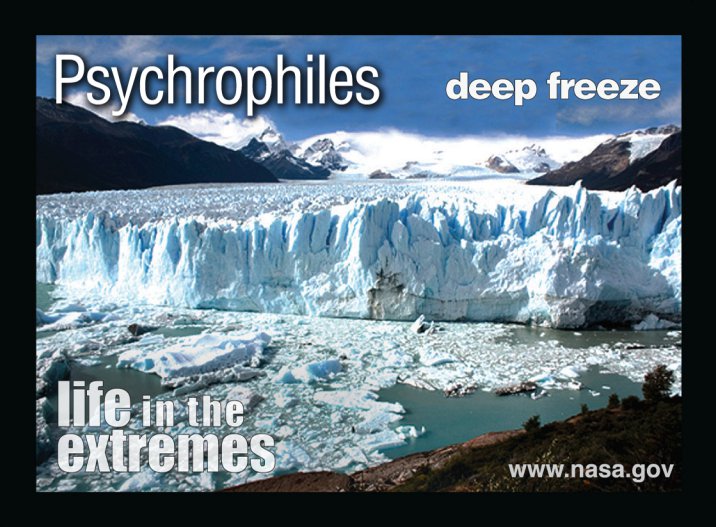
In Part I of our subglacial environments discussion, we talked about how glaciers on Earth support unique habitats for life where they interact with underlying bedrock. These niches can be small microenvironments with just enough water and minerals to support microbial life. But there are also much larger environments to be found – huge caches of water trapped beneath the bulky, frozen ice known as subglacial lakes. These bodies of water have been a major research focus of astrobiology.
Subglacial lakes can support extremophiles that can thrive in cold, dark, low-nutrient environments.These lakes are also excellent places to test technology and techniques for future exploration missions beyond our planet. Some moons in the Solar System, such as Europa and Enceladus, harbor oceans of liquid water beneath their thick, icy shells. Could subglacial lakes on Earth teach us important lessons about searching for life on these ocean worlds?
- Life as we know it requires three ingredients: energy, organic molecules, and liquid water. Astrobiology, our search for life beyond Earth, is a search for planets, dwarf planets, and moons that harbor substantial liquid water. We call these places “ocean worlds.” Credit: NASA Goddard
Forming a Subglacial Lake
There are two main ways in which subglacial lakes are thought to form. The first is through meltwater, which creates environmental niches for organisms that have a role in weathering and carbon cycling beneath these icy behemoths (see Part I). Sometimes meltwater can pool together into much larger habitats – giant lakes that lay trapped beneath the ice at the boundary between the glacier and underlying bedrock.
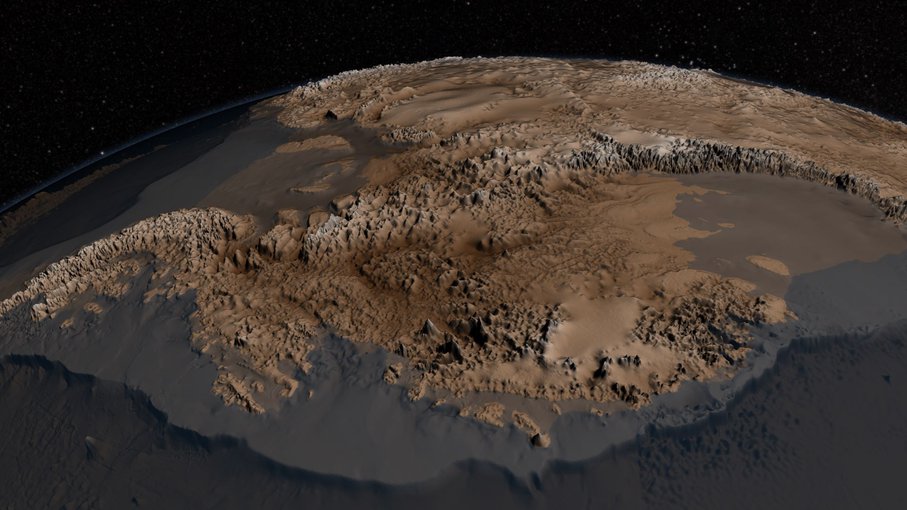
Bedrock map of Antarctica developed in 2013 from IceBridge and other data was far more detailed than previous maps, giving researchers and modelers new information about how ice flows or sticks on the rock below the Antarctic ice sheet.Image credit: NASA / Cynthia Starr.
The second way is to trap seawater in ice when the climate cools. Some subglacial lakes are thought to have formed when the ancient Earth transitioned from warm periods with high sea level into colder periods with glaciers. During these transitions, water froze into glaciers in places like Antarctica, and could have trapped large caches of seawater as the oceans receded. These subglacial lakes are thought to have been isolated from the planet’s atmosphere for thousands, tens of thousands, and maybe even millions of years.
When subglacial lakes are isolated for long periods of time, what happens to the life that lives in them? And how does this life survive? Those are fascinating questions for astrobiologists, and the answers could teach us important lessons about the mechanisms that life uses to survive in harsh conditions, such as extreme cold, high salinity, and low nutrients. Understanding these mechanisms could be important in determining how life as we know it might persist on other worlds in the Universe.
Shaping Life in Subglacial Lakes
Subglacial lakes can be divided into two broad categories based on the behavior of the water from which they are formed. Some of the lakes are closed systems that are isolated from the atmosphere and meltwater at the surface of the glacier. Other lakes are connected to vast hydrological systems, rivers and streams of pressurized, liquid water that flow under the ice sheet. These are two important distinctions in understanding the habitats of subglacial lakes.
Closed systems are lakes covered and surrounded by the glacier in such a way that meltwater from the surface of the glacier doesn’t reach them. These lakes are truly isolated, and any life in them has to survive using the limited amount of material available. These lakes tend to get very salty because no new freshwater is being added to the original pool. The water is motionless with no subglacial rivers running in or out of the lake and permanent ice caps that prevent wind-generated waves from mixing things up. This allows the water column to separate into distinct layers with varying conditions (such as temperature, salinity, and dissolved gasses). Each of these layers can represent a unique environment for life.

An artist's conception of the Antarctic subglacial environment.Image credit: Zina Deretsky, NSF.
The second type of subglacial lake is one that is fed by a hydrological system underneath the glacier. Meltwater from the top of the glacier can seep down through cracks to feed entire systems of rivers and streams. This pressurized water is forced around below the glacier to feed into and out of lakes, and it provides some connection between them.
Subglacial fluid that flows in these hydrological systems beneath glaciers doesn’t always collect to form a lake. That’s the case for Antarctica’s Taylor Glacier, where subglacial fluid pours out of the glacier at the site of Blood Falls (See Part I).
Extreme Subglacial Water
Most life on Earth depends on the Sun for energy, but not all life. Deep below the oceans, hydrothermal vents provide energy that supports entire ecosystems. Under the right conditions, subglacial lakes might also be an example of ecosystems that are built around energy sources other than the Sun. Many organisms in subglacial lakes rely on interactions between the water, ice, and sediments. These places are extremely cold, low-nutrient environments, and extremophilic microorganisms known as psychrophiles have adapted to survive there.
Psychrophiles survive in some of Earth's coldest environments. Check out the set of trading cards featuring nine different extremophile groups at: https://astrobiology.nasa.gov/classroom-materials/tradingcards/Image credit: NASA Astrobiology.
In terms of exploring the Universe, one of the biggest reasons for astrobiologists to study subglacial lakes is simply figuring out how to access, sample, and learn about them. The technology and techniques used to do this could be stepping stones to the types of instruments we need to get below the icy surfaces of ocean worlds like Europa and Enceladus. These moons of Jupiter and Saturn are two of the primary locations of interest in the Solar System for astrobiologists. Many scientists wonder if the oceans beneath the surface of these moons could be habitable for life, and whether or not organisms might be living in their waters today.
- Dr. Morgan Cable, from the NASA Jet Propulsion Laboratory! Dr. Cable is a Technologist in the Instrument Systems Implementation and Concepts Section at NASAJPL, and the Assistant Project Science Systems Engineer for the Cassini Mission, which explored the Saturn system for over 10 years.
Where on Earth?
By far, the largest collection of subglacial lakes on Earth is found toward the southern pole of the planet in Antarctica. In fact, Antarctica was the first place where these bodies of water were discovered. Over 400 subglacial lakes have now been identified in Antarctica alone, but subglacial lakes have also been spotted in places like Greenland, Iceland, and Canada.
In 2022, over 700 subglacial lakes were cataloged by a team of scientists at Sheffield University in the United Kingdom, including lakes in glacial alpine valleys (1). Together, these hidden bodies of water are likely to contain a significant portion of Earth’s liquid freshwater. That study also estimated that 80% of the lakes are stable, which means they are either closed systems that do not interact with the world outside of the glacier… or they have a balanced flow of water coming into and out of the lake.
Out of the hundreds of subglacial lakes found on Earth, relatively few have been studied up close by scientists. Let’s take a quick tour of some of the highlights.
Lake Vostok, Antarctica

An artist's cross-section of Lake Vostok, the largest known subglacial lake in Antarctica. Liquid water is thought to take thousands of years to pass through the lake, which is the size of North America's Lake Ontario.Image credit: Nicolle Rager-Fuller / NSF.
The largest known subglacial lake on Earth is Antarctica’s Lake Vostok. In fact, this lake is currently thought to be the 16th largest lake in the world by surface area. Lake Vostok is covered by a layer of ice that is around 4000 meters thick, and some studies have estimated that the lake has been isolated from direct inputs from the surface for around 420,000 years (2). The 4000 meters of ice is all glacier until around 3310 meters. From 3310 to 3539 meters, the ice is a mix of glacial ice and frozen ice from the waters of Lake Vostok, known as accretion ice. Below 3539 meters, the ice is all accretion ice that rests underneath the glacier itself.
In the late 1990s, a team of astrobiologists drilled down 3623 meters below Vostok Station at the surface of the glacier (3). They stopped short of reaching Lake Vostok’s water in order to avoid contaminating the lake, but the team did collect samples of the accretion ice. In those samples, they found microorganisms that had been frozen into the ice. This showed that Lake Vostok might support a microbial population.
Lake Vostok continues to be an active site of study for scientists, and new information is gathered through tremendous engineering efforts to dig down through the ice and collect samples (Gramling 2013). All of this has to be done very carefully so as not to contaminate the lake, which is thought to have been isolated from the atmosphere for millions of years.
Lake Mercer, Antarctica

The Hot Water Drill, UV Collar, and borehole at the subglacial Lake Mercer in Antarctica. This photo is from the 2018/19 Field Season of the Subglacial Antarctic Lakes Scientific Access (SALSA) project, supported by the NSF’s Office of Polar Programs.Image credit: National Science Foundation’s Office of Polar Programs.
Lake Mercer covers 160 square kilometers and has a depth of around 15 meters. Like other subglacial lakes, the temperature of the water in Lake Mercer is below 0°C, but the immense pressure of the estimated 1067 meters of ice above helps to keep the water liquid. The water in Mercer is connected to a hydrological system below the ice, and isn’t completely isolated from the outside world. Scientists think that the water in the lake could be replaced with water from the ocean over a period of 10 years.
From December 2018 to January 2019, a team of astrobiologists and other scientists supported by the National Science Foundation Office of Polar Programs drilled over 1200 meters into the ice above lake Mercer as part of the Subglacial Antarctic Lakes Scientific Access (SALSA) project. Videos documenting the team’s work are available from the SALSA project website.
Lake Whillans, Antarctica
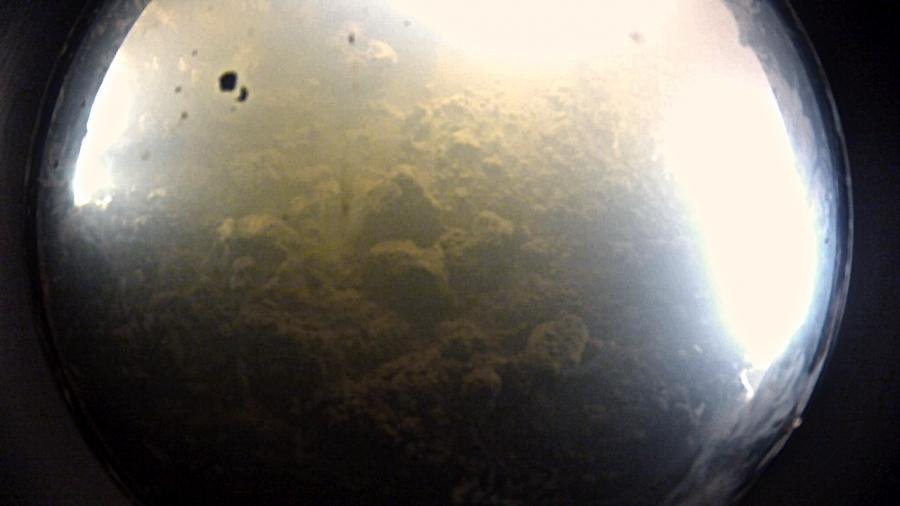
The first view of the sediments at the bottom of Lake Whillans.Image credit: Dr Alberto Behar, JPL/ASU/NSF/NASA.
Lake Whillans was the focus of the Whillans Ice Stream Subglacial Access Research Drilling (WISSARD) project, which was one of the few efforts thus far to break through the ice into a subglacial lake. (See the video below to learn about Ice Streams). To do so, the team drilled 800 meters through the West Antarctic Ice sheet using a hot water drill. They extracted two samples of lake water and sediment from the lake bed, and discovered methanotrophs (‘methane loving’) microbes that metabolize methane for energy.
- Ice streams are corridors of ice that flow faster than the surrounding ice of the glacier. Yes ice can flow! It just flows a lot slower than liquid water). Ice flows discharge ice and sediment from the ice sheet.
Greenland (Lake 1 and Lake 2)
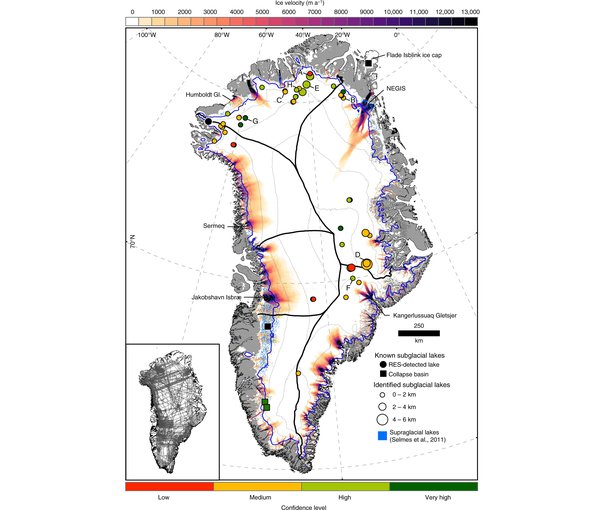
Spatial distribution of subglacial lakes identified in radar echo sounding data. Lakes are colour-coded according to confidence level and proportionate in size to the length of the lake reflector.Image credit: Bowling JS, et. al. (2019) Distribution and dynamics of Greenland subglacial lakes. Nature Communications, 10(92810). DOI: 0.1038/s41467-019-10821-w.
In 2012, scientists with NASA’s Operation IceBridge used radar from an airplane to identify subglacial lakes beneath the Greenland ice sheet (5). The lakes in Greenland are unusual compared to subglacial lakes in Antarctica, and are trapped beneath relatively thin and cold ice (like liquid water, ice can also vary in temperature). The scientists weren’t sure if these lakes are ancient saline water that has been closed off from the outside world for a long period of time, or if they are part of an open hydrological system where freshwater flows beneath the ice.
With further study, the scientists identified 56 subglacial lakes in Greenland (6). They concluded that it is most likely that the Greenland lakes are fed by meltwater from the surface. If meltwater is being supplied to the base of the glacier, the Greenland ice sheet could have an extensive drainage system beneath the ice that keeps many subglacial lakes from forming. But only further studies of Greenland will tell us for sure.
Devon Ice Cap

(A) Landsat image overlain with the location of the subglacial lakes beneath the Devon Ice Cap (blue) and ice divides (black). (B) Bedrock topography. (C) Relative reflectivity along the radar transects atop of bedrock contours.Image credit: Rutishauser, A., et al. (2018) Discovery of a hypersaline subglacial lake complex beneath Devon Ice Cap, Canadian Arctic, 4(4). DOI: 10.1126/sciadv.aar4353.
In 2018, scientists supported in part by NASA Astrobiology used radio-echo sounding to find two subglacial lakes beneath the Devon Ice Cap in the Canadian Arctic (7). These two lakes are unique because of the environment that surrounds them. They are found in bedrock troughs in a mountainous area, and likely contain hypersaline water well below the freezing point of water. It is thought that these lakes do not receive any meltwater from the surface of the glacier, and the saltiness of the water could be partially caused by the salt-bearing geological formations that surround the lakes. Scientists don’t know how these lakes formed, and whether or not they are connected in any way to sources of groundwater.
Subglacial Lakes and Earth’s Climate
Subglacial lakes also have an important role to play in Earth’s climate. These trapped bodies of water influence how ice flows into oceans (8). As we mentioned, not all subglacial lakes are completely isolated. Some lakes in Antarctica are part of a vast subglacial system of waterways under the ice. This can transport ice from the interior of Antarctica toward the ocean. A NASA study in 2007 found that this process might release enough water to affect the global sea level of the Earth.
Getting Under the Ice
Subglacial lakes are incredibly hard to study and access. First, you have to travel across some of the Earth’s most challenging terrain just to reach their location, and while hauling heavy scientific equipment. Then, you have to make it through ice that can be kilometers thick. New drilling technologies are being developed and tested in order to get down to the bodies of liquid water without contaminating them with life from the surface. But because of the difficulty, very few of these projects have been attempted.
The WISSARD project at Lake Whillans is one example of advanced technology that gave astrobiologists access to a lake deep, deep below the ice. The WISSARD team dropped a small, baseball bat-like, robotic submarine through a hole in the ice that was made using a special hot water drill. This ‘Micro-Submersible Lake Exploration Device’ was the first of its kind, and was loaded with chemical sensors and cameras to characterize its surroundings once it reached the lake. WISSARD was designed to work at depths of up to 1.2 kilometers and could travel up to a kilometer from the bottom of the borehole where it entered the lake.

The WISSARD team after the completion of a successful drilling mission into subglacial Lake Whillans.Image credit: Photo courtesy of the WISSARD Science Team.
Subglacial lakes aren’t the only environments on Earth where these technologies and methods are tested. Some glaciers on Earth extend away from land over the ocean. When a glacier is big enough (more than 50,000 square kilometers), it is referred to as an ice sheet or continental glaciers. The portions of these massive glaciers that extend out over the ocean are called ice shelves.
In Antarctica, the U.S. Antarctic Program’s McMurdo Station provides relatively easy access to one such location. McMurdo Station is located on Ross island in the McMurdo Sound. The sound itself is covered by the McMurdo Ice Shelf (which is actually just a section of the larger Ross Ice Shelf).
McMurdo station has been used as a base to test vehicles that can be lowered down through holes in the ice to explore the sea underneath. One such explorer was the small, under-ice vehicle known dubbed Icefin. This robotic oceanographer gathered data on the water column, the ice, and the seafloor.
- Dr. Britney Schmidt, Assistant Professor of Earth and Atmospheric Sciences at Georgia Tech, USA. Dr. Schmidt is an expert in Icy & Ocean Worlds.
Another example of using the ice shelf to test technology for the exploration of icy moons is the ARTEMIS (Autonomous Rovers/airborne-radar Transects of the Environment beneath the McMurdo Ice Shelf) underwater vehicle.
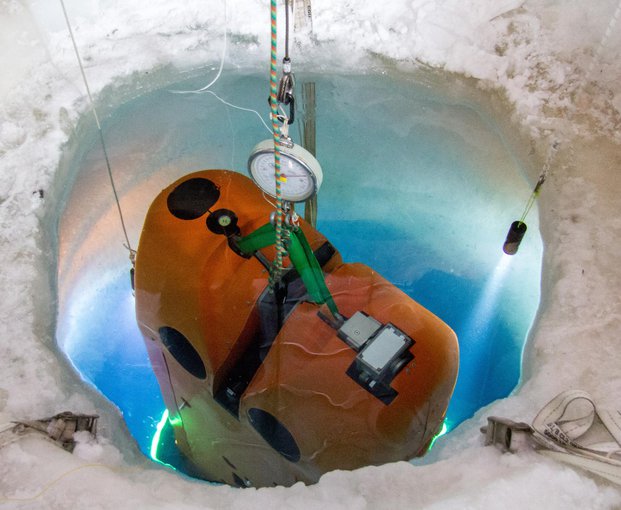
The ARTEMIS submersible vehicle being lowered into the water, where it will descend several kilometers below the McMurdo Ice Shelf.Image credit: Justin Lawrence/SIMPLE.
Although not trapped beneath glaciers, there are other lakes on Earth that are permanently covered with ice. The surface of these lakes, many found in Antarctica, have frozen surfaces that never thaw. The ice covering these lakes isn’t nearly as thick as a glacier, so light from the Sun can actually make it through to the water to support photosynthesizing microorganisms. The relatively thin ice cover on these lakes also makes them a good test bed for equipment that could later be used in subglacial lakes. A few examples of permanently ice-covered lakes are Lake Fryxell, Lake Vida, and Lake Joyce in the Antarctic Dry Valleys.
Other bodies of water can sometimes be found perched above a glacier, and are referred to as supraglacial lakes. These lakes sit on debris-covered ice on top of the glacier and are typically formed by meltwater or rain. Perched lakes are more temporary than subglacial lakes, and can last from months to decades. If cracks or fissures form in the ice, the water quickly drains into and/or out of the glacier itself, sometimes in a matter of hours.
Liquid water reservoirs might also be trapped in ice on other worlds according to a new NASA study. Jupiter’s moon Europa has an ocean of liquid water beneath its surface, but observations from ground-based telescopes and NASA’s Galileo orbiter have also shown that salty bodies of water could be present at different depths inside the moon’s thick, icy shell. The study uses computer models to predict the potential behavior of these lakes, and future observations by NASA’s upcoming Europa Clipper mission could reveal more about their properties.
As much data as possible is also being gathered without actually touching the waters, and instead using the integration of geophysical data, remote monitoring with satellites, and computer modeling. Developing these technologies and techniques are important in understanding how climate change on Earth will affect these delicate systems, and it is also advancing our capabilities to explore environments trapped under ice on other ocean worlds in the Solar System.
- For 11 years from 2009 to 2019, the planes of NASA’s Operation IceBridge flew above the Arctic, Antarctic and Alaska, gathering data on the height, depth, thickness, flow and change of sea ice, glaciers and ice sheets. Credit: NASA
Space, the Frozen Frontier
Subglacial environments have become an increasingly important area of study in astrobiology as robotic missions have provided more and more details about the worlds in our solar system. Data from the MARSIS (Mars Advanced Radar for Subsurface and Ionosphere Sounding) instrument onboard the European Mars Express orbiter has raised questions about whether or not Mars might have liquid water trapped beneath the ice at the planet’s poles. In addition, numerous moons and protoplanets in the Solar System have the potential to support bodies of water beneath their icy surfaces.

Vents in Europa’s icy crust could allow plumes of water vapor to escape from a sub-surface ocean. If observed up close, the chemical components of the plumes would be identified and could help explain the nature and history of the ocean below.Image credit: NASA.
Jupiter’s moon Europa could have an ice shell that is 15 to 25 kilometers thick that covers an ocean 60 to 150 kilometers deep. Europa is only one-fourth the diameter of Earth but its ocean could contain more than twice as much water as all of Earth’s oceans combined.
Saturn’s moon Enceladus also has an ocean of liquid water beneath its frozen surface, which is thought to have an average thickness of about 20 to 25 kilometers. However, the ice could be as thin as 1 to 5 kilometers at the south pole where plumes of water spew out to reach hundreds of kilometers into space.
The potential for life in the subsurface oceans of these icy worlds is one of the biggest questions in astrobiology today.
Related Links:
Ask An Astrobiologist: The Potential for Life on Titan, Europa, & Enceladus with Dr. Morgan Cable
Ask An Astrobiologist: Robot Explorers on Icy Worlds with Dr. Britney Schmidt
Antarctica’s Subglacial Lakes Support Prospects For Life On Icy Moons
Subglacial Antarctic Lakes Scientific Access (SALSA) Project (NSF Office of Polar Programs)
Antarctic Ice Sheet’s Hidden Lakes Speed Ice Flow Into Ocean, May Disrupt Climate (NASA)
Microbial Mats Offer Clues To Life on Early Earth
Antarctic Microbes Hold Clue to Earth’s Oxygen
Microbial Mats Adapting to the Cold
NASA Researchers Discover Ancient Microbes in Antarctic Lake (NASA)
WISSARD (Whillans Ice Stream Subglacial Access Research Drilling) (Montana State)
Operation IceBridge (NASA)
NASA Study Suggests Shallow Lakes in Europa’s Icy Crust Could Erupt (NASAJPL)
References
1. Livingstone, S.J., et al. (2022) Subglacial lakes and their changing role in a warming climate. Nature Reviews: Earth and Environment, 3. DOI: 10.1038/s43017-021-00246-9
2. Priscu, J., et. al. (1999) Geomicrobiology of Subglacial Ice Above Lake Vostok, Antarctica. Science, 286(5447) DOI: 10.1126/science.286.5447.2141
3. Christner, B.C., et al. (2001) Isolation of bacteria and 16S rDNAs from Lake Vostok accretion ice. Environmental Microbiology, 3(9). DOI: 10.1046/j.1462-2920.2001.00226.x
4. Gramling, C. (2013) What’s Really Going on in Lake Vostok? Science. DOI: 10.1126/article.24463
5. Palmer SJ, et. al. (2013) Greenland subglacial lakes detected by radar. Geophysical Reearch Letters, 40(23). DOI: 10.1002/2013GL058383
6. Bowling JS, et. al. (2019) Distribution and dynamics of Greenland subglacial lakes. Nature Communications, 10(92810). DOI: 0.1038/s41467-019-10821-w
7. Rutishauser, A., et al. (2018) Discovery of a hypersaline subglacial lake complex beneath Devon Ice Cap, Canadian Arctic, 4(4). DOI: 10.1126/sciadv.aar4353
8. Dowdeswell JA, Siegert MJ. (2003) The physiography of modern Antarctic subglacial lakes. Global and Planetary Change, 35(3–4). DOI: 10.1016/S0921-8181(02)00128-5
9.



